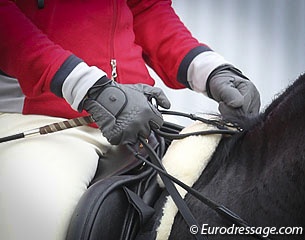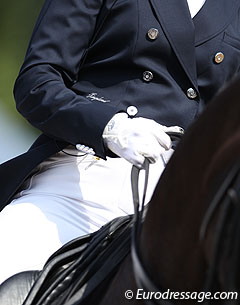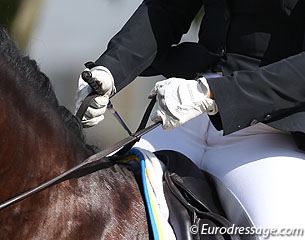
Earlier in the year, with the help of some of the dressage world's top riders and trainers, I set out to define dressage. Now, I hope to define the dressage rider's greatest weapon, the signature of their technique in the saddle, the half halt. It is unique to every rider and is not something that can really be theorized or taught, it must be learnt; either by feeling or application on different horses, in different ways, until you find that "aha" moment.
For Olympian and well known British trainer Carl Hester, the half-halt is a bracing of the back, a halt and release that must be made within a stride and for the elite rider made completely invisible. "The first thing to think in half-halt is to make it invisible to those watching on, which is easier said than done," Carl told Eurodressage. "I usually do the half-halts at every transition in the test, to balance the horse in preparation for the following movement."
While early on in training a horse may need to be rebalanced more readily, Carl advises that by the time a horse is at Grand Prix level, they really should have the ability to stay in their own balance in between the movements "Riding a Grand Prix horse, the half-halts should only really be in the transitions - so really a rider would do as many half-halts in a test as there are transitions and a well-educated horse should stay in his own balance if just trotting down the long side, without the rider needed to guide him," he said.
Certain that the half-halt is unique to every rider, Carl believes that some people do it invisibly and some people don't, all depending on the balance and physique of the rider.
"Riders with a big upper body will find it more difficult to half-halt invisibly but if they have an effective half-halt the horse will not seem to change anything during the rebalance, particularly the length in his frame. Riders without an effective half-halt will be forced to use the rein and will result in a disruption in the rhythm and/or a shortening of the horses neck."
The art of the invisible half halt then, according to Carl, is to not only do it so that no-one sees the rider's aid, but also that no one sees any change in the horse and, particularly, without a change in the length and openness of the horses neck.
So if the half-halt should be invisible, what should be achieved through the half-halt?
"The aim of the half-halt is not only to balance the horse but to ask him to take more weight on the hindlegs," Hester explained. "For sure, some horses need more half-halting than others and this all depends on the horse’s reaction to the bit. Some horses are very light-mouthed and therefore require less half-halting and more forward aids from the rider, others are heavier into the contact and a rider may need to half-halt lots to lighten the horse in front."
 According to Carl, the major role of the half-halt in dressage is to refine the transitions and the half-halt should not be used in a way that it keeps the horse behind the bit.
According to Carl, the major role of the half-halt in dressage is to refine the transitions and the half-halt should not be used in a way that it keeps the horse behind the bit.
"If a rider has an ineffective half-halt, you will see a shortening in the neck, whereas a rider with an effective half-halt will execute a moment where they will stop/start without losing the forward impulsion and frame," he said. "A half-halt should be completed in half a stride and the art of the half-halt is then being able to effectively ride extension to collection without any change in the horses rhythm."
For German Olympian, Ingrid Klimke, the half-halt is where the rider sinks into the saddle and takes a deep breath. "Close your legs and engage the hind legs of the horse to step more under the centre of gravity, then close both fists, not hold against the horse, just close them."
Agreeing that the half-halt is unique to every rider, Ingrid believes that each rider is different just like each horse, but that every rider must learn the proper half-halt through the use of the seat, not the reins. "The half halt is the most important aid and is necessary to ride all movements if you are to successfully influence the horse with invisible aids. You need it the most before you do anything else as the half halt is first to tell your horse. "Listen, something is changing and coming, sit on your hind legs and balance to be ready for me to ask it," she said.
Without the half-halt, Ingrid believes there will be no communication between the behind and the front of the horse, and the rider will not be able to achieve anything correctly. "I usually half-halt every second stride if I feel that my horse tends to change, or if I need to support him."
Knowing that the half-halt is a feeling that must be developed, Ingrid says it is not enough just to be taught the half-halt on the horse but that one must understand it's theory, it's role, and practice it's execution out of the saddle. "First thing is to study the theory of the half-halt. Then, sit on a chair and do it. Finally, try it on a horse who reacts to a half-halt to feel how the horse should react," Klimke added.
From a younger perspective, 20 year-old Italian Young Rider Arianna Petroncini is still on her way to learning the half-halt and feels that she is not as capable as Isabell Werth in clearly explaining the term, yet she does have some ideas.
"When I do a half-halt, I try to bring the weight of my horse on his behind (his back), in this way I can set free the front of the horse and so I can feel him more soft in my hands, while he is staying in the contact. After the half-halt, he should be able to carry himself more easily. He may have more self carriage and be more uphill,” said Arianna.
With the half-halt, Arianna tries to make her horse aware about what she is asking him and in line with Ingrid's thinking, she believes it's as if she is telling her horse, "Hey, pay attention please, I’m asking something of you”. "I think that every rider has his own way to do a half-halt, connected with the type of horses that they ride. There are riders that use more hands and less legs and vice versa, but in my opinion, if I have a horse really soft in the contact I have to use less hands and more legs."
 Adamant that the half-halt has an important role in dressage, Arianna says that when you have to ride a test, it’s important to prepare every movement, and with the half-halt you can do just that. "Without it you crash into movements, with no preparation, putting your horse in a difficult position if he is to carry out your requests. For example, he can’t do a good shoulder-in if you don’t prepare it in the corner, sitting him back with a half-halt.
Adamant that the half-halt has an important role in dressage, Arianna says that when you have to ride a test, it’s important to prepare every movement, and with the half-halt you can do just that. "Without it you crash into movements, with no preparation, putting your horse in a difficult position if he is to carry out your requests. For example, he can’t do a good shoulder-in if you don’t prepare it in the corner, sitting him back with a half-halt.
The half-halt in dressage is the balancer, the reinforcer, the reminder, the rejuvenator, the engager, and the tool to draw the horse's attention back onto the work. Yet, we still see many riders who instead of perfecting the half-halt with their seat, pull on the reins, shortening more and more the horse's neck until he submits to being pulled around the dressage arena.
What is really happening here, is that the rider is trying to half-halt before establishing the correct position on the horse and so must compensate their own lack of balance by using leg and rein simultaneously to ask the horse to engage, and thus trap the horse and force him into submission.
A half-halt will not work if the rider is not in a balanced position on the horse and will be particularly ineffective if the rider is tight and cannot feel what the horse is doing. The main problem we see in the dressage arena is people who have been told how to do the half-halt when they are stiff and tight and so the horse does not feel the action of the rider's back and gets strong into the rider's hand.
Nuno Oliveira didn't use the term half-halt, but knew that the rider must learn over time to use their seat, back, breathing, and feeling, to guide the horse. "Use hands and legs sparingly, and maintain balance through the seat" N.Oliveira (1998, 33).
To establish the art of lightness, one must be able to maintain and balance that lightness with an effective and subtle half-halt, and until the rider can effectively carry out this process, well, Ingrid puts it nicely: "No half-halt, no dressage!"
by Sarah Warne for Eurodressage
Photo © Astrid Appels
Related Link
Sarah Warne's Classical Training Articles